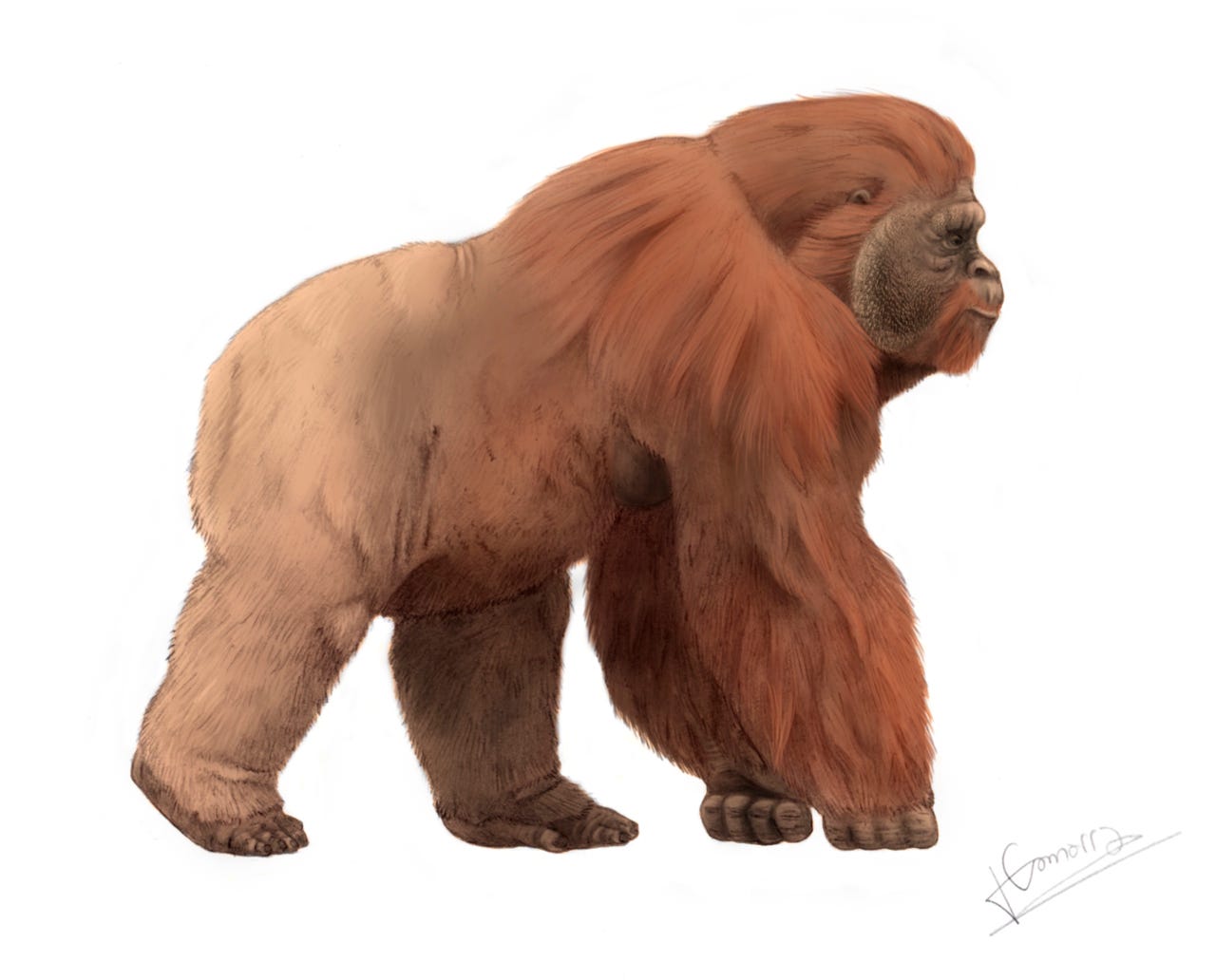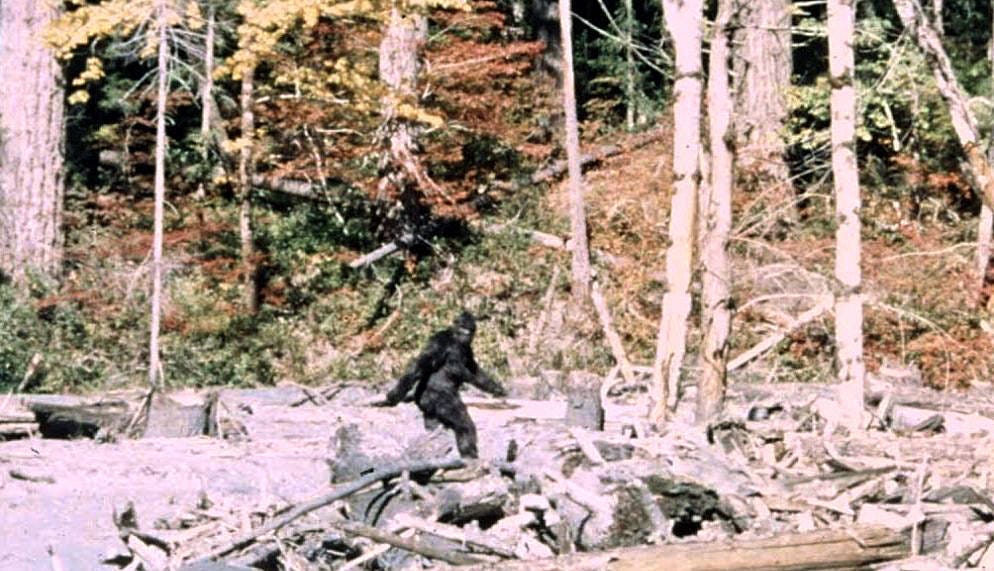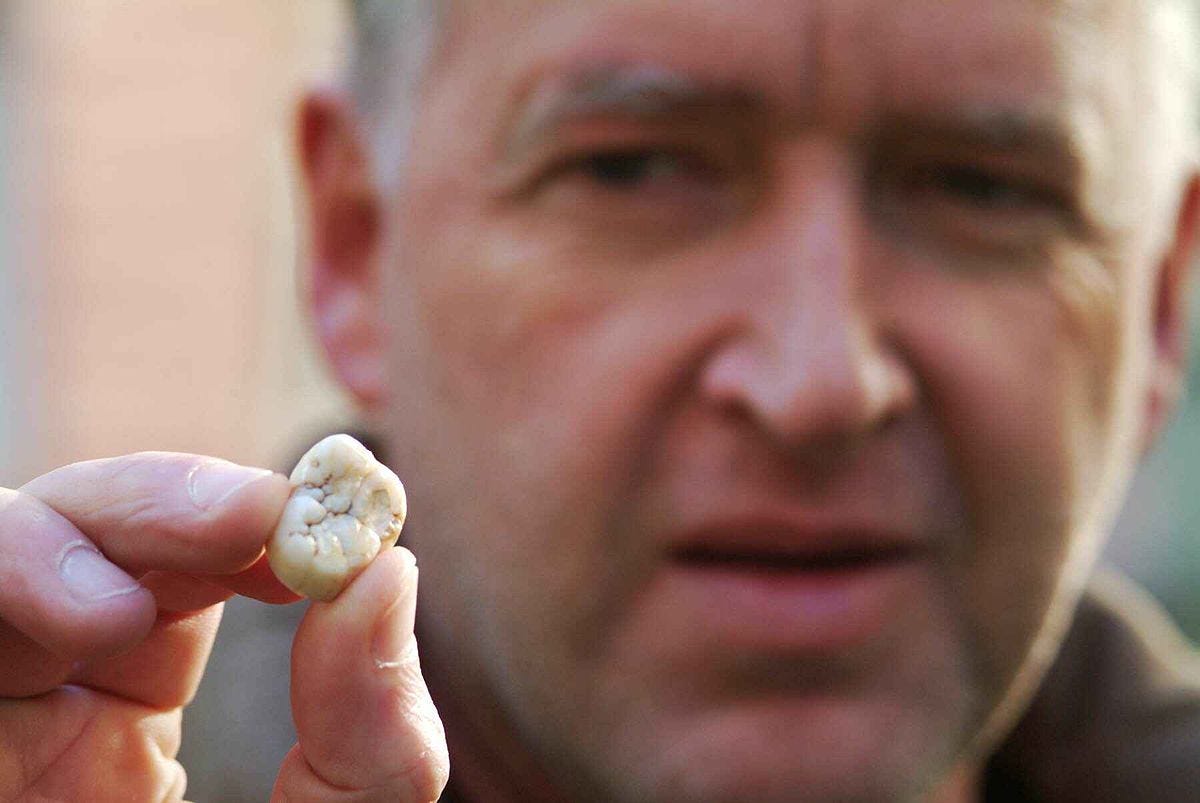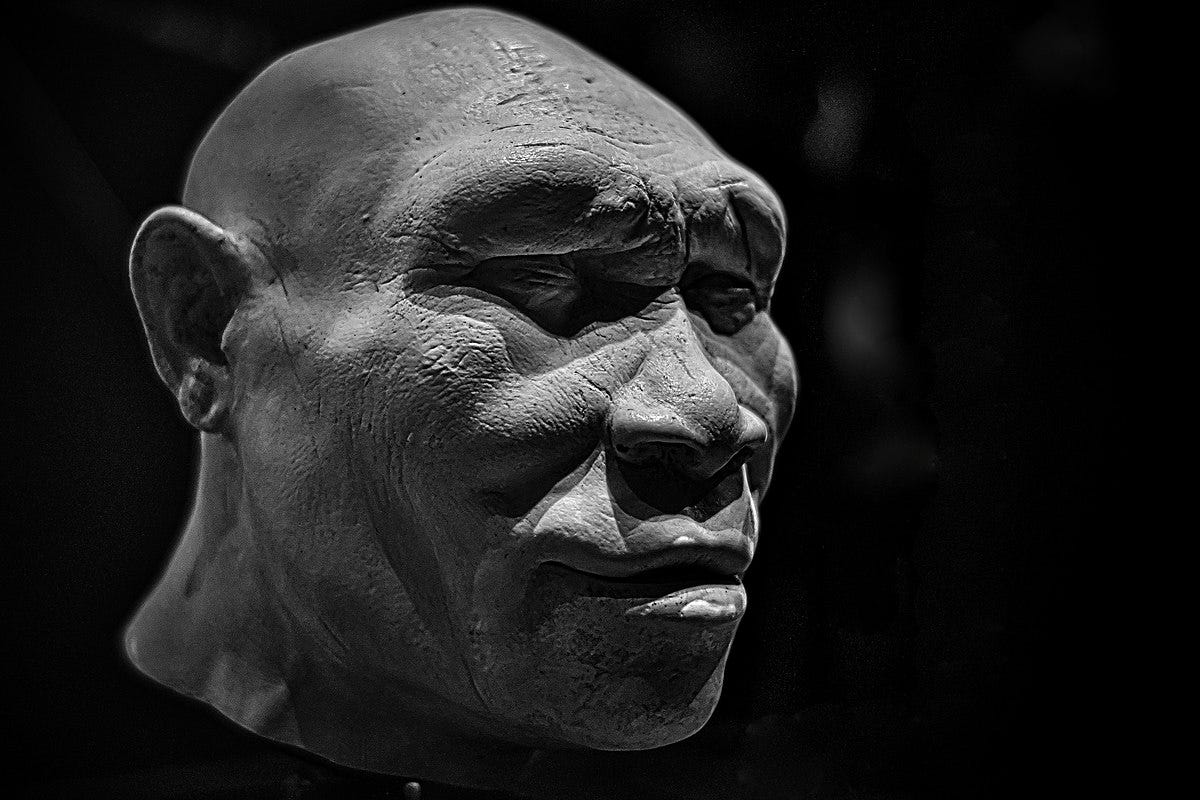Gigantopithecus: The Real-Life Bigfoot
This 10-foot tall behemoth was the greatest great ape that ever lived

As dawn breaks on a lush and leafy forest - in what will become South China in a little over 300,000 years’ time - hundreds of birds erupt in a chorus of cheeps and chirps. The canopy is suddenly awash with life and light but below, on the forest floor, shadows still linger. In a dense thicket of bamboo, so tall that it blends into the canopy above, there’s a loud snap as a hulking mass of orange fur parts two stems. It pauses and looks side to side, waiting to see if the sound stirred others potentially lurking in the undergrowth. Nothing.
It carries on, quieter this time, as it continues its search. On the edge of the thicket it finds a fig tree and slumps down against its wide trunk, its legs resting within the tree’s sprawling aerial roots. It reaches out, grabs a handful of vibrant purple fruits and stuffs them into its cavernous cheeks. There’s a squelch, followed by a slurp as it tries, and fails, to stop a glob of saliva, juice and seeds from escaping the corner of its mouth and running down its chest. This is Gigantopithecus, and it's breakfast time.
The grandfather of Bigfoot
For as long as tales of Bigfoots, Yetis, Yowies, and Abominable Snowmen have been told, people have been searching for a real-life example to tie their mythical apes to. Just one look at Gigantopithecus - a 10-foot tall, 300 kg giant - and it’s clear why many have chosen this archaic primate as their likely candidate for an elusive, bi-pedal beast that supposedly stalks the forests of the Pacific Northwest, the valleys of the Himalayas and the Outback of Australia.
Gigantopithecus is considered the grandfather of Bigfoot by many cryptozoologists, the long-lost ancestor of perhaps the most famous cryptid of all time. No one pedalled the ‘Gigantopithecus = Bigfoot’ theory more than Grover Krantz, an American anthropologist and cryptozoologist who was widely described as the “only scientist” to seriously believe in the existence of Bigfoot.

Krantz argued that a small population of Gigantopithecus survived past their suspected extinction date around 300,000 years ago, uprooted their lives in South Asia and moved to North America via the Bering Strait land bridge that connected modern-day Russia and Alaska during the many glacial episodes which took place during the Pleistocene.
That is, interestingly, an almost identical route to the one which our early ancestors followed on their way into the Americas around 16,000 years ago; though - and this goes without saying - this momentous event in prehistory actually happened. A transcontinental migration of forest-dwelling, fruit-guzzling great apes, on the other hand, did not (and we know that because of the evidence, or perhaps more accurately: the complete lack thereof).
From the 1970s up until his death in 2002, Krantz kept pushing for a connection between Gigantopithecus and Bigfoot, even putting forward a taxonomic classification for his made-up beastie - Gigantopithecus canadensis. This was hurriedly thrown out, as was his paper titled ‘A Species Named from Footprints’. Still, his work has outlived him and his theories continue to be discussed today, inspiring a new wave of media-savvy cryptozoologists who can, rather impressively, condense millions of years of skewed prehistory into a 30-second-long TikTok.
Bigfoots, Yetis, Yowies, and Abominable Snowmen are, of course, not real. Gigantopithecus was, however, and for nearly nine million years it occupied a very specific niche in the dense, subtropical forests of what is now South China and Vietnam.
An unlikely discovery
Many new species of ancient animals are described from fossils that are found in situ, entombed within rocks that formed shortly after they died. Some are described from previously misidentified fossils deep within museums’ collections. Gigantopithecus, however, may be the only one to have been discovered while rooting through the draws of a pharmacy.
The first pieces of Gigantopithecus were found in 1935 by Dutch palaeontologist Ralph von Koenigswald who, during a visit to a pharmacy in Hong Kong while on the hunt for ‘dragon’s teeth’ (a traditional Chinese medicine said to cure acute mania), found several huge molars. These molars were broad and flat, similar to those of apes, but they were bigger than those from any known species - living or extinct. Von Koenigswald found similarly large teeth in other nearby pharmacies; which, along with his type specimen, he promptly assigned to a brand-new genus: Gigantopithecus, or ‘giant ape’. However, it would take almost two decades before he was able to formally describe his mysterious giant.

Von Koenigswald spent much of the 30s and 40s working as a palaeontologist for the Geological Survey of Java - the most populated of Indonesia’s 6,000 inhabited islands. When World War II broke out and the Japanese invaded Indonesia, Von Koenigswald was interned in a prisoner-of-war camp. For a while he was presumed dead, leading many of his colleagues to begin assigning names to some of his undescribed discoveries. This wasn’t the end for Von Koenigswald, however, and he escaped the hands of the Japanese relatively unscathed with his vast collection of fossils largely intact. A few years later, in 1952, he finally described the discovery he made almost 20 years previously.
In the years that followed, Von Koenigswald’s work was picked up by a team of Chinese palaeontologists who were tasked with finding the original Gigantopithecus locality. Like their Dutch colleague, they found numerous fossilised teeth amongst shipments of ‘dragon’s teeth’, this time in Guangdong and Guangxi - regions of South China. In 1956, the team discovered the first in situ remains of Gigantopithecus - a molar and premolar - in a cave nestled under Niusui Mountain in Guangxi. By 1963, more than 1,000 teeth had been collected, as well as several mandibles (jaw bones).
Since then, no other parts of Gigantopithecus’ predictably colossal skeleton have been uncovered. Nevertheless, from the known material - >1,000 teeth and four mandibles - researchers have been able to reconstruct this huge creature from the jaw downwards, as well as identify three distinct species within the Gigantopithecus genus: bilaspurensis, giganteus and blacki. The latter, Von Koenigswald’s holotype, was the biggest, as well as the one which lived most recently, inhabiting South China and Vietnam from the Early Pleistocene (~2 ma) to, at least, the late Middle Pleistocene (~300 ka).
From isotopic analysis of its tooth enamel, we know that Gigantopithecus lived in dense and humid closed-canopy forests, just like its extant cousins gorillas and orangutans. Like these contemporary primates, it would have walked on all fours - the knuckles on its thick-set hands in step with its huge feet. It would have also displayed a large degree of sexual dimorphism (differences between males and females), as gorillas and orangutans also do. This is inferred, again, through its teeth, specifically its canines which are typically 37% larger in presumed males than in presumed females. Such a high level of dimorphism suggests that Gigantopithecus lived in patriarchal societies where there would have been a lot of competition between males.
While they looked and lived a lot like gorillas, Gigantopithecus’ closest living relatives are in fact orangutans. This was deduced by a study which measured the thickness of the enamel on their teeth, as well as the shape of the dentin (the softer, squishier material underneath the enamel) within their teeth. The results of this study, conducted quite recently in 2019, helped securely place Gigantopithecus on the ape’s crowded family tree as close cousins of orangutans, and distant cousins of gorillas, chimps and us. The study also calculated that Gigantopithecus and orangutans shared a common ancestor some 12 million years ago, around the Middle to Late Miocene.
Bigger isn’t always better
Gigantopithecus may be closely related to orangutans, but they must have had a very different way of life. For starters, orangutans are arboreal animals - the kind that spend most of their time in trees. Tipping the scales at ~300 kg, it’s impossible to imagine that Gigantopithecus also spent its time jumping around the forest’s canopy. Instead, researchers have hypothesised that they were ground dwellers; again, much like gorillas.
The sheer size of Gigantopithecus raises a series of pertinent questions: what does a colossal, ground-dwelling ape eat? And how much does it need to eat to keep itself alive? The first question has been the subject of many studies since its discovery almost a century ago, and together these studies have painted an incredibly detailed picture of Gigantopithecus’ diet.

From morphological studies of its teeth (flat and wide) and jaws (deep and strong), we can tell that it must have eaten a lot of tough and fibrous plants, like bamboo shoots. Further microscopic studies have also identified phytoliths on a select sample of teeth. These phytoliths - tiny silica structures found in some plant tissues even after decay - closely resemble the hairs of fruits from the fig family, which includes figs, mulberries, breadfruits and banyans. This, coupled with the high cavity rate (11%) in collected teeth, points towards sugary fruits being a large component of Gigantopithecus’ diet.
Less is forthcoming about the second question posited above, but it’s clear that such a large creature would have had to consume a lot of calories to survive. There was clearly enough food to satisfy Gigantopithecus’ voracious appetite in the subtropical forests that it lived, and we know that based on the fact that it evolved to fill that particular niche and - for several million years - thrived within it. To achieve such a massive size, food must have been plentiful. That said, bigger isn’t always better and many researchers have argued that Gigantopithecus’ size is what ultimately contributed to its demise.
Throughout the Middle Pleistocene, South China experienced some rapid climate changes which dramatically shrunk its subtropical forests. Vast savannas, covered in homogenous grasses, became the dominant habitat across this part of Asia - a death knell for an animal so reliant on the calorific fruits that its home once provided. Had Gigantopithecus been smaller, then it may have been able to adapt to this new environment. This is an argument put forward by evolutionary biologist Hervé Bocherens who, in a study published in 2017, suggested that Gigantopithecus’ closest living relatives orangutans have survived similarly devastating climatic upheavals “thanks to their low metabolism and reduced dietary needs during times of food shortage.”
Size also presents a risk when it comes to nurturing the next generation. On average, large animals tend to have fewer babies and typically those babies take much, much longer to mature than those a tenth of their size. As a result, populations are generally smaller and thus more sensitive to fluctuations. From studies of Gigantopithecus’ teeth we know that it matured very slowly, meaning populations were likely small. This alone could have driven Gigantopithecus to extinction, so when combined with a dramatic loss of habitat during the Middle Pleistocene it’s no real surprise that they were ushered out, and ushered out fast.
New kids on the block
A decline in available habitat and a slow reproduction rate aren’t the only hypothesised drivers behind Gigantopithecus’ extinction, some researchers have argued that the giant ape’s distant cousins, Homo erectus, also had some input. These archaic humans are just a couple of steps removed from us on the Hominin family tree, and like us they spanned a large area of the globe during their prime. Those who lived in Asia during the Pleistocene lorded over the savannas and, for a time, were the apex predators in that particular environment. As Gigantopithecus’ habitat shrank and they were forced further and further into the savannas, they likely encountered erectus.

It’s worth noting that there’s no direct fossil evidence of any interactions between Gigantopithecus and erectus, though considering that their remains have been found in similar areas around the same time, it’s not too much of a reach to imagine that the two great apes clashed. Whether these clashes took the form of squabbles over fallen fruits on the forest-savanna margin, life and death fights as erectus hunted Gigantopithecus, or perhaps a combination of both, is unknown, and will remain unknown until we find some more concrete evidence.
Whatever the drivers behind its extinction, Gigantopithecus vanished some time around the transition between the Middle and Late Pleistocene, ~300 ka. A few studies have argued that some smaller, relict populations survived deeper into the Late Pleistocene, facing extinction at ~100 ka, though the evidence for that is limited to just two sets of dental remains found in Lang Trang cave in northern Vietnam and Shuangtan Cave in southern China.
Interestingly, erectus also faced extinction at ~100 ka and, like Gigantopithecus, probably as a result of rapid climate changes and a subsequent reduction in its habitat. The last known populations of erectus lived on Java, which was apparently the easternmost extent of their reach. These relict erectus, known from an incredible site along the Solo River that yielded 14 skullcaps, two tibia and a piece of a pelvis, were uncovered by none other than Von Koenigswald himself. Even if Gigantopithecus and erectus never met, their lives are inextricably intertwined through their connection with one of the greatest palaeontologists of his days.
Blame the porcupines
Gigantopithecus may only be a distant relation of ours, but it’s still crucially important in helping us to parse the branches on our cluttered family tree. Only so much can be understood from just teeth and a handful of jaw bones, though. To fully realise this giant ape and understand how it lived we need to uncover much more of its skeleton. You’ve no doubt been asking yourself this question for a while now: why have we found so few remains of Gigantopithecus? And why are those remains limited, largely, to just its teeth?
The most common explanation for a dearth of skeletal material is the fuzzy nature of the fossil record. The conditions needed to create fossils are rare and, as a result, only a very, very small percentage of animals - and their constituent parts, mind you - will ever be fossilised. But that’s not the explanation that researchers have plumped for in the case of Gigantopithecus, at least it’s not the main one.
Instead, blame has been pinned on a cheeky rodent that lived alongside Gigantopithecus in the subtropical forests of South China and Vietnam - porcupines. These spiky creatures chew on bones to obtain nutrients necessary for quill growth. Through study of modern-day porcupines, we know that they’re capable of hauling large amounts of bones into their underground dens where they then proceed to gnaw them into oblivion. They can’t quite digest the hard, enamel-capped crowns of teeth though, which is likely the reason why we tend to find these parts of Gigantopithecus and not others. There’s direct evidence of this pesky, bone-eating behaviour too, with many tooth roots showing signs of gnawing.

As palaeontologists we often ask ourselves how many of Earth’s ancient animals were “lost to time?” This revelation raises a new question that we should perhaps be asking, “how many were lost to porcupines?”
Name: Gigantopithecus
Meaning: Giganto, literally meaning “giant”, while pithecus comes from the Greek pithēkos, meaning “ape”.
Size: Stood upright, Gigantopithecus blacki (the largest of three documented species) would have measured 3 m (10 ft) tall, though it's worth noting that size estimates are highly speculative since only teeth and several jaw bones are known
Weight: 200-300 kg
Age: Late Miocene (9 mya) - Middle/Late Pleistocene (~300 ka, but could be as late as 100 ka)
Type of organism: Great ape
Environment: Subtropical evergreen broadleaf forests
Closest Living Relatives: Orangutans, or Pongo (pygmaeus, abelii, tapanuliensis)
References
Bocherens, H., Schrenk, F., Chaimanee, Y., Kullmer, O., Mörike, D., Pushkina, D. and Jaeger, J.J., 2017. Flexibility of diet and habitat in Pleistocene South Asian mammals: Implications for the fate of the giant fossil ape Gigantopithecus. Quaternary International, 434, pp.148-155.
Ciochon, R.L., 1991. The ape that was. Natural History, 100(11), pp.54-63.
Lopatin, A.V., Maschenko, E.N. and Dac, L.X., 2022, June. Gigantopithecus blacki (Primates, Ponginae) from the Lang Trang Cave (Northern Vietnam): The Latest Gigantopithecus in the Late Pleistocene?. In Doklady Biological Sciences (Vol. 502, No. 1, pp. 6-10). Moscow: Pleiades Publishing.
Regal, B., 2008. Amateur versus professional: The search for Bigfoot. Endeavour, 32(2), pp.53-57.
Zhang, Y. and Harrison, T., 2017. Gigantopithecus blacki: a giant ape from the Pleistocene of Asia revisited. American Journal of Physical Anthropology, 162, pp.153-177.
* Thumbnail adapted from original artwork. CC BY-SA 4.0, available here.




